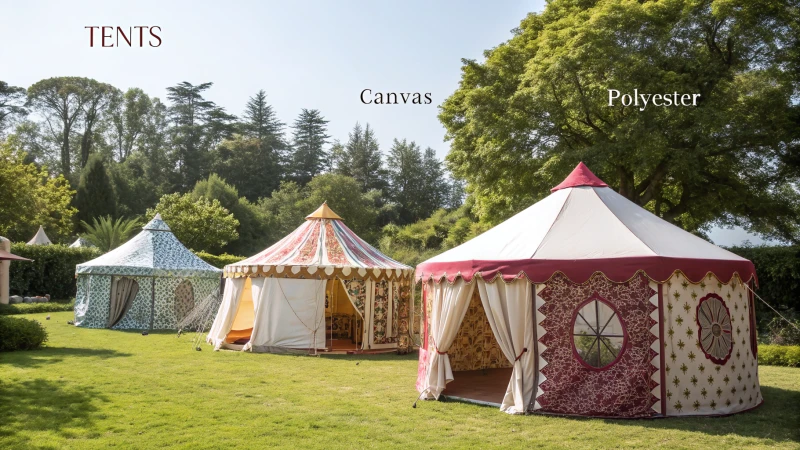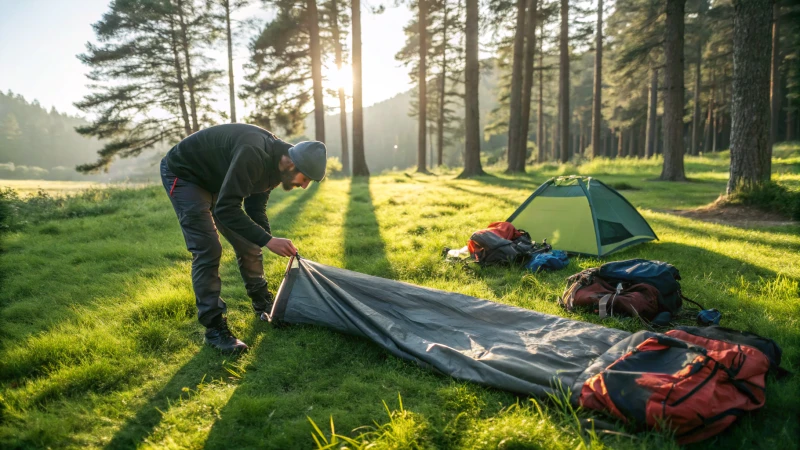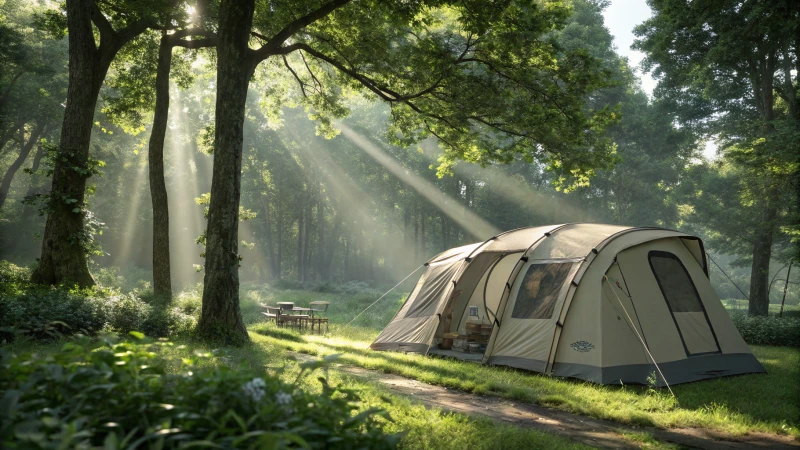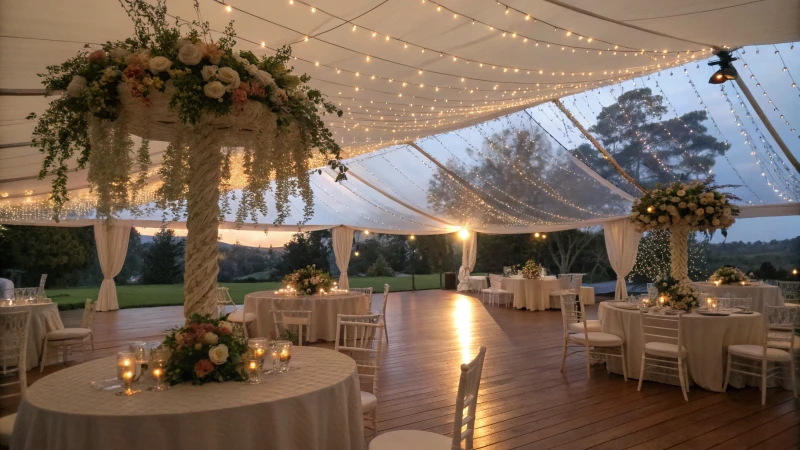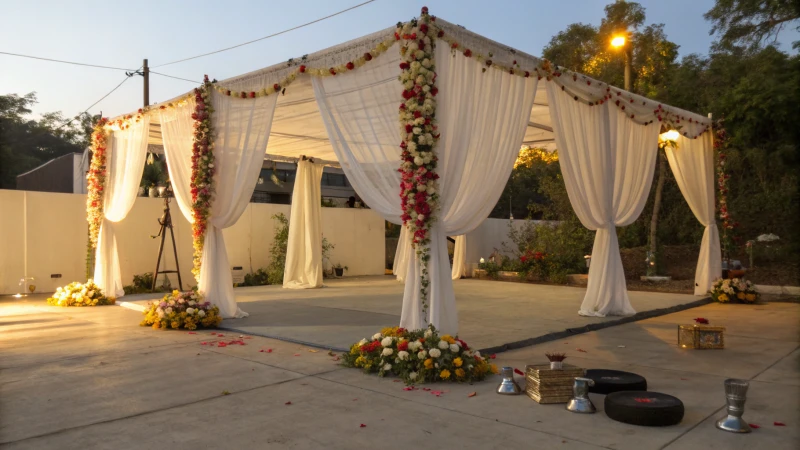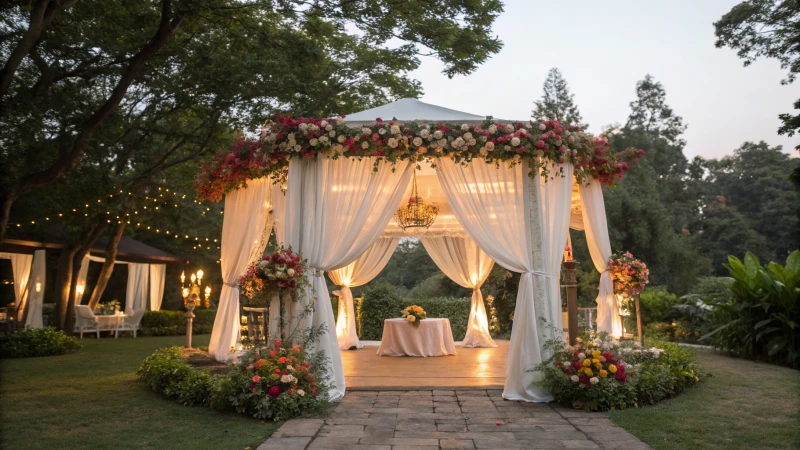
I remember the butterflies in my stomach when I first started planning my outdoor tent wedding.
To plan an outdoor tent wedding successfully, focus on the tent size, fabric choice, ventilation, and flooring. These essentials ensure both style and comfort for your guests.
I still recall walking through endless fields of wedding tents, trying to imagine how each one could transform into the magical setting of my dreams. While it seemed daunting at first, breaking it down into manageable pieces made all the difference.
The tent size was crucial because it needed to comfortably accommodate everyone on our guest list while keeping the budget in check. I learned that sharing these details with the tent provider helped us find the perfect fit without feeling cramped or overspending. Choosing between transparent and non-transparent fabrics was another big decision. Opting for a clear tent meant basking in the natural beauty of the sky and landscape, which we couldn’t resist.
For comfort, flooring was essential. We went with a combination of wood flooring and carpeting to ensure our guests could dance the night away without worrying about sinking into grass or uneven ground. And let’s not forget about ventilation; an absolute must for a summer wedding to keep everyone cool and content.
Incorporating personal touches like floral arrangements, elegant lighting, and colorful ribbons added warmth and personality to the space, making it uniquely ours. With these tips in hand, I hope your tent wedding planning feels more like a creative journey than a chore.
Choosing transparent tent fabric enhances natural lighting.True
Transparent fabrics allow natural light, creating a bright ambiance.
Non-transparent tents are cooler than transparent ones.False
Non-transparent tents trap more heat, making them warmer.
How Do You Choose the Right Size Tent for Your Wedding?
Ever tried to squeeze too many people into a small space? It’s a nightmare! Picking the right tent size for your wedding avoids that drama.
To choose the right tent size for your wedding, start by nailing down your guest count and layout preferences, like seating and dance floor, plus any extras like catering zones or entertainment stages.
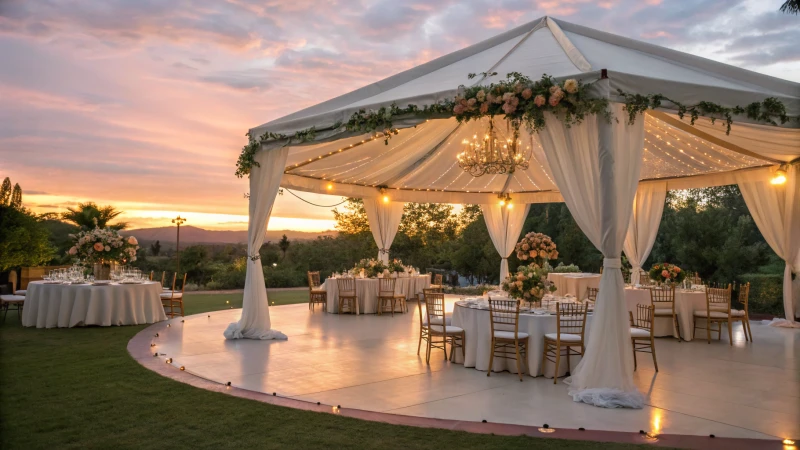
Determining the Number of Guests
The guest list can be both exciting and daunting, right? I remember when we were planning our wedding, I kept rechecking my list, wondering if Cousin Joe would bring a plus-one. Once you’ve nailed down your numbers, use the guideline of 10-12 square feet per person to ensure everyone feels comfortable. If your heart is set on a lively dance floor or an impressive stage for Uncle Bob’s band, consider expanding the space.
Use this basic layout:
| Feature | Space Required |
|---|---|
| Seated guests | 10-12 sq ft/pax |
| Dance floor | 2-4 sq ft/pax |
| Stage | 20-24 sq ft |
| Buffet/Bar | 100+ sq ft |
Considering the Venue Environment
Oh, the joys of outdoor weddings! My best friend’s ceremony was under a beautiful blue sky until a surprise drizzle had us all running for cover. So, if you’re going al fresco, make sure your tent can handle unexpected weather. In summer, ventilation is key—nothing worse than melting in the heat. Choose wisely among options like sturdy materials1 such as PVC or canvas.
- Clear Top Tents: These are magical for starlit evening weddings. They create an intimate yet open feel.
- Pole Tents: Perfect for soft grounds like gardens.
- Frame Tents: The go-to choice for rocky or hard surfaces.
Customizing Tent Features
Let’s face it, personal touches make all the difference. I once attended a wedding with stunning clear walls that showcased a breathtaking mountain view. Think about what will elevate your event—perhaps adding glass doors for that extra touch of elegance or whimsical drapes and floral arrangements2 to match your theme.
Consulting with Tent Providers
Don’t hesitate to tap into the wisdom of professional tent suppliers. They’ve seen it all and can guide you to the best fit for your numbers and venue. When we consulted with ours, they had fantastic insights that aligned perfectly with our vision and budget. Discuss everything from logistics to style, ensuring your tent truly reflects the spirit of your day.
For more inspiration, explore tent design trends3 to discover creative ideas that could transform your celebration.
10-12 sq ft per guest is standard for wedding tents.True
This space allocation ensures comfort and movement for seated guests.
Frame tents are best for soft ground like gardens.False
Frame tents are ideal for hard surfaces, while pole tents suit soft grounds.
What are the Best Fabric Options for a Wedding Tent?
I remember the thrill of picking the perfect wedding tent fabric, knowing it could make or break the magical ambiance we dreamed of.
The best fabric for a wedding tent depends on your needs: PVC-coated polyester offers durability and weather resistance, while polycarbonate panels provide a sleek, modern look. Consider transparency, weather conditions, and your desired ambiance when choosing.
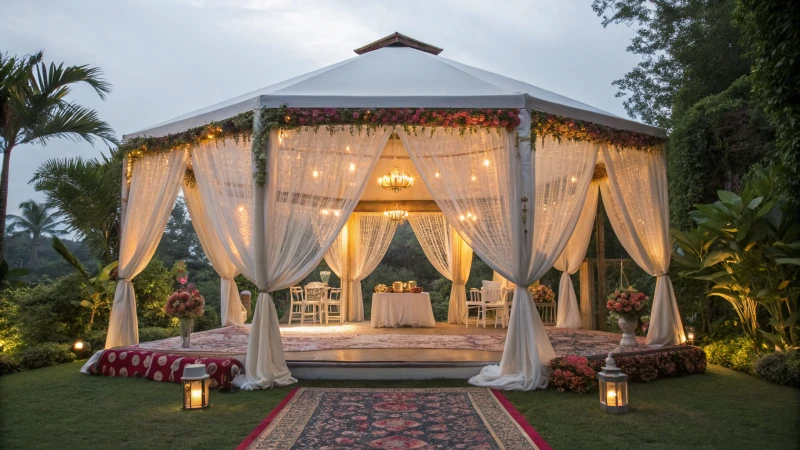
Durability and Weather Resistance
When I was planning my cousin’s outdoor wedding, the weather was my biggest concern. I knew I needed a fabric that could stand up to whatever Mother Nature threw at us. That’s when I discovered PVC-coated polyester. It’s like having a superhero shield over your celebration, battling winds, rain, and UV rays. It gave us peace of mind knowing our guests would be comfortable, come rain or shine.
| Fabric Type | Durability | Weather Resistance | Aesthetic Appeal |
|---|---|---|---|
| PVC-coated | High | Excellent | Modern |
| Polyester | Medium | Good | Versatile |
| Polycarbonate | High | Excellent | Sleek |
Transparency and Aesthetic Appeal
Choosing between transparent and opaque fabrics was another big decision. I remember standing in a sun-drenched field, imagining how a transparent tent would let the light dance around us, with polycarbonate panels inviting the sky inside. It felt like we were in a dream, surrounded by nature’s beauty. Yet, I had to consider that these clear tents could turn into mini-greenhouses under the summer sun without proper decorations4.
For those wanting a more controlled setting, non-transparent polyester can be magical too. It allows you to play with lighting inside the tent, crafting an atmosphere that’s intimate and enchanting.
Budget Considerations
Balancing dreams with dollars is always a tricky part of wedding planning. While polycarbonate offers stunning aesthetics and durability, its price tag can be daunting. I found polyester to be a lifesaver—it was budget-friendly yet still stylish. It reminded me that sometimes, the most memorable moments aren’t about splurging but making thoughtful choices. We carefully weighed our guest list against our budget, ensuring we could create an unforgettable experience without breaking the bank.
By considering these factors, you can choose a wedding tent fabric that blends functionality with style, leaving you and your guests with cherished memories of a beautiful day.
PVC-coated polyester is highly weather-resistant.True
PVC-coated polyester withstands winds, rain, and UV rays effectively.
Polycarbonate tents are budget-friendly options.False
Polycarbonate offers aesthetics and durability but is more expensive.
How Can You Decorate a Wedding Tent for Maximum Impact?
Creating an unforgettable wedding atmosphere in a tent is like painting a masterpiece where every stroke counts.
To decorate a wedding tent for maximum impact, start by choosing a theme that resonates with your vision, then layer in strategic lighting and personal touches. Natural elements and the tent’s inherent structure can be artfully used to enhance both aesthetics and comfort.
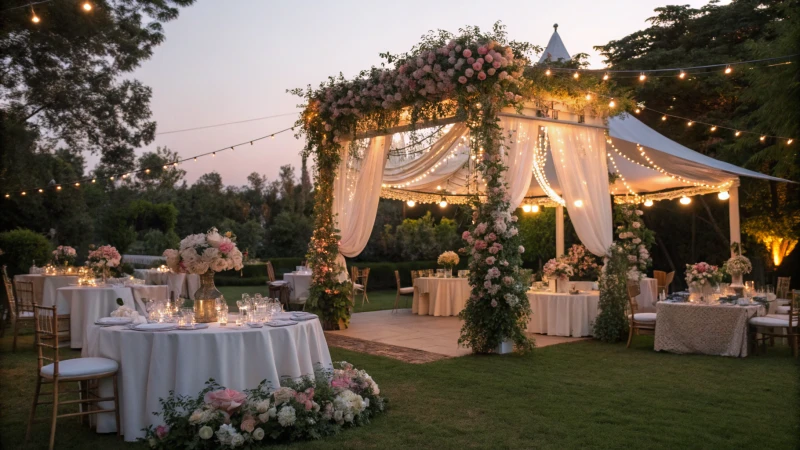
Choosing the Right Theme
I remember when I first had to transform a plain white tent into a magical wonderland for a friend’s wedding. It all started with selecting the right theme. Themes like rustic chic, elegant glamour, or bohemian romance can guide you in picking colors, fabrics, and accents. For instance, if you’re dreaming of a rustic wedding, think about incorporating wooden accents5 and earth-toned decor.
| Theme | Key Elements |
|---|---|
| Rustic Chic | Wooden accents, burlap, wildflowers |
| Elegant Glamour | Crystal chandeliers, gold accents |
| Bohemian Romance | Dreamcatchers, lace, colorful florals |
Lighting Magic
Lighting can transform any space, and in a tent, it’s no different. I once attended a wedding where fairy lights were draped across the ceiling, casting a warm glow that made everything feel intimate and cozy. Consider string lights for that enchanting vibe or chandeliers for a touch of elegance. LED uplighting can highlight the tent’s structure beautifully while dimmers let you adjust brightness as day turns to night.
Explore options like hanging lanterns6 or spotlight effects7 to make key areas stand out. Not only does good lighting set the mood, but it also ensures everyone can see each other and the beautiful details of the evening.
Incorporating Natural Elements
Bringing in natural elements can really make a tent feel alive and vibrant. I once saw floral arches that framed the entrance of a tent so beautifully it felt like stepping into another world. Hanging floral installations create stunning focal points, and using seasonal flowers not only keeps things fresh but also budget-friendly.
For a more sustainable approach, consider potted plants or succulents that double as guest favors—it’s a lovely way to say "thank you" while also staying eco-friendly. Explore eco-friendly decor options8 that align with green wedding trends.
Personalizing with Details
Personal touches are what make an event truly memorable. Think back to any wedding you’ve attended where you felt the couple’s personality shining through every detail. Custom signage, monogrammed tableware, or personalized seating cards can add those special touches that make guests feel cherished.
A photo wall or guest book area can reflect your journey as a couple while customized banners9 or unique centerpieces tie personal elements into the decor seamlessly. Just remember to keep everything consistent with your theme for maximum impact.
String lights create an enchanting atmosphere.True
String lights add warmth and a magical ambiance to the tent.
Rustic themes often use crystal chandeliers.False
Rustic themes typically use wooden accents, not crystal chandeliers.
What Weather Considerations Should You Plan For?
Planning an event is like preparing for a dance with Mother Nature—always be ready for her unpredictable steps!
Prepare for all weather scenarios by selecting appropriate equipment and taking preventive measures. Focus on location-specific conditions, temperature extremes, and potential natural events to ensure everyone’s safety and comfort.
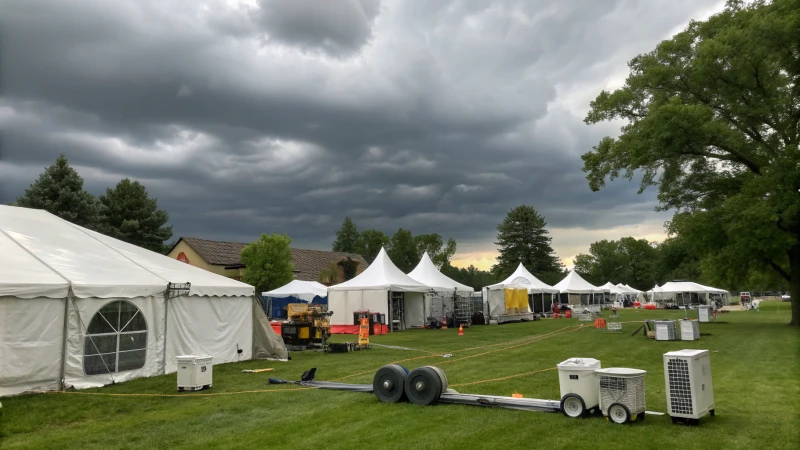
Types of Weather to Consider
When it comes to planning for weather, think of it like preparing for a surprise party thrown by Mother Nature. You know the usual guests—rain, wind, and temperature fluctuations—but occasionally, you’ll get those unexpected drop-ins like hail storms10 or flooding11.
| Weather Type | Key Considerations |
|---|---|
| Rain | Waterproof materials, drainage systems |
| Wind | Sturdy structures, tie-downs |
| Temperature | Heating/cooling systems, shade provision |
Choosing the Right Equipment
Choosing the right gear is like dressing for a first date—it’s all about making a good impression while staying comfortable. I’ve found that transparent tents12 are stunning but can turn into saunas without proper cooling. On the flip side, opaque tents might be your cozy choice.
Emergency Preparedness
I remember once when a sudden storm caught us off guard during an outdoor event. It taught me the importance of having a solid backup plan. Knowing local weather patterns and keeping emergency supplies13 handy is crucial. Don’t forget a reliable communication system to stay updated with weather alerts.
Monitoring Weather Patterns
These days, technology is your best friend. I always use weather apps14 to keep an eye on evolving conditions. It’s like having a personal weather advisor that helps you make quick, informed decisions.
By keeping these factors in mind, you can make sure that your event or business isn’t just a success but a safe haven against the whims of weather.
Rain requires waterproof materials and drainage systems.True
Waterproof materials and proper drainage prevent water damage during rain.
Transparent tents are ideal for all weather conditions.False
Transparent tents can overheat in hot climates, needing extra cooling.
Conclusion
Planning an outdoor tent wedding involves choosing the right size, fabric, and decor while considering comfort and weather conditions to create a memorable experience for guests.
-
Learn about durable materials that withstand various weather conditions, ensuring your wedding goes smoothly. ↩
-
Discover floral arrangement ideas that complement tent interiors and enhance wedding themes. ↩
-
Stay updated with current design trends to create a memorable and stylish wedding setting. ↩
-
Discover creative decoration ideas to enhance transparent wedding tents. ↩
-
Explore rustic wedding decor options that complement wooden accents and earthy tones for an authentic and charming setting. ↩
-
Discover various hanging lantern options that add warmth and ambiance to any wedding tent setup. ↩
-
Learn about innovative spotlight techniques to highlight key areas of your wedding tent for enhanced visual appeal. ↩
-
Find sustainable decor solutions that minimize environmental impact while maintaining beauty and elegance. ↩
-
Check out customized banner ideas that add a personal touch to wedding decorations, enhancing guest experience. ↩
-
Learn how to protect your event from hail damage with practical tips and strategies. ↩
-
Explore effective strategies to protect your business from flood risks. ↩
-
Discover the aesthetic benefits of transparent tents and how they enhance event ambiance. ↩
-
Get a comprehensive list of emergency supplies needed for outdoor events. ↩
-
Find top-rated apps that provide accurate and timely weather updates. ↩


